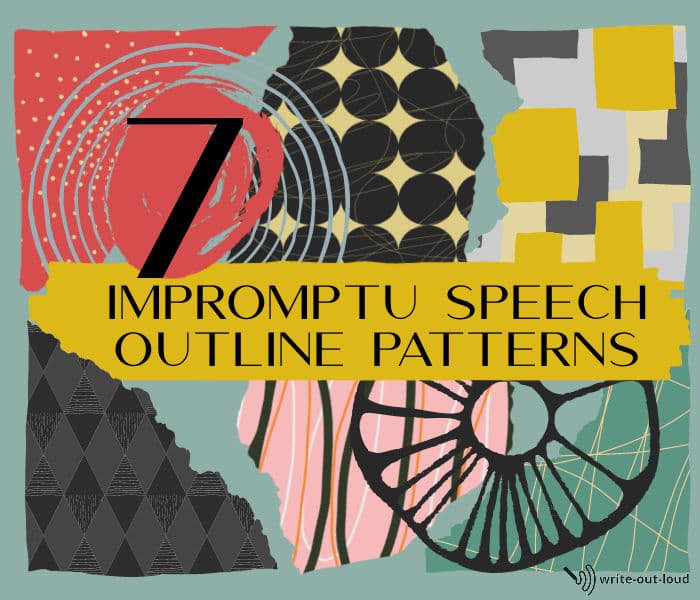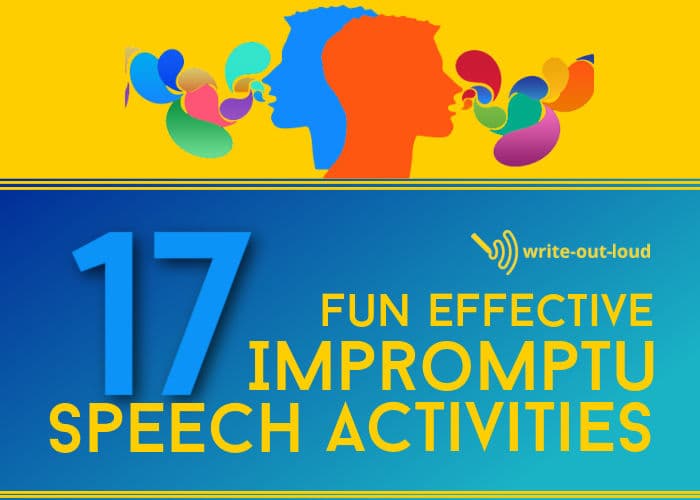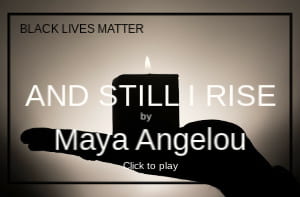- HOME ›
- Impromptu speaking tips ›
- Impromptu speech outlines
Impromptu speech outline: 7 formats
How to prepare for an impromptu speech
By: Susan Dugdale
Using a speech outline to prepare an impromptu speech seems counterintuitive, doesn't it? After all, impromptu means of the moment, spontaneous, without preparation. So, what is an impromptu speech outline?
Quite simply it’s the structure, or format of your speech. It’s how you order your material from the time you open your mouth at the beginning of your speech, until you close it at the end.
An outline doesn’t need to be a written document or put on note cards to be effective. An experienced impromptu speaker will have an assortment of structural patterns memorized. When they’re asked to speak, they’ll mentally flick through them and choose the most appropriate.
Following an outline lessens the possibility of rambling aimlessly off topic. And, given my flibberty gibbet tendencies it's vital! Maybe yours too?☺
What's on this page
Seven structural patterns, each with example impromptu speech outlines and a printable blank outline template to download.
How to use these structural patterns: guidelines for practice
About the printable impromptu speech outlines
How to reframe a topic: examples of openings showing how to adapt a topic.
The patterns are:
- Point, Reason, Example, Point (PREP)
- Past, Present, Future
- Problem, Solution
- Pros/Cons, Positives/Negatives, For/Against, Advantages/Disadvantages
- Cause, Effect, Remedy
- Before/The Event/The Result
- Local, National, International

How to use these structural patterns
To become a competent impromptu speaker you need to get familiar with them. So initially just play with them for practice either with a friend or by yourself.
- Get a subject to talk about. (Click for 150 impromptu speaking topics).
- Choose yourself a pattern to form the body of speech.
- Now go. Open your mouth and speak.
You’ll need an introduction followed by your material organized according to whatever pattern you’ve selected, and then a conclusion.
Keep it simple. You
don’t need to try hard to say devastatingly intelligent insightful
things. The starting goal is to get used to thinking, then speaking,
without a great deal of prior preparation.
This is impromptu speaking, ‘off the cuff’, largely spontaneous. Be honest and where you can, add personal stories. Your own experiences, plus your knowledge of the subject, will establish rapport and credibility. Don’t be afraid to experiment, or 'fail', as that's how you'll learn.
If your content at this stage is trite nonsense and you putter out of ideas too soon, so be it.
Once you’re used to a pattern, and can follow it easily without having to stop and think about which part comes next, you’ll naturally come up with better material.
About the printable impromptu speech outlines
Along with examples to illustrate each impromptu speech outline structure there's a link to a blank printable. There are seven of them: one for each pattern. They are there for you to use as a guide. You'll find the links for them below the example outlines.
Each outline has the same four step format.
The first step is mentally preparing yourself: sorting out your topic, considering your audience and working out what tone best fits with them, as well as your speech purpose.
The second step covers preparing the introduction, the third, the body, and the fourth and final step, the conclusion.
Your chosen structural pattern is the body
The third step, the body of your speech, holds the specific pattern you’re working with. It’s this step, the body, you’ll want to focus on first when you’re practicing. After you’ve set your topic allow yourself a few minutes to think it through (or make notes) using the pattern headings as a guide.
Once you feel comfortable with the body, you’ll find the openings and conclusions become much easier.
Getting the time and content balance right
The overall length of your speech or the time you take to deliver it is, to a large part, determined by how much information you put into the body. Obviously one or two main points and their supporting material will take less time than three or four.
(Practice will help you confidently and reliably get the balance of time to content right. Click the link for examples of one minute speeches prepared using the Point-Reason-Example-Point (PREP) pattern. They'll give you an idea of what's required.)
Practice, practice, and then do it some more
You don’t need to follow each of the four steps of the outline slavishly. However, to use that old cliché, before you can run, you need to know how to walk. So before giving yourself permission to try to improvise and dazzle publicly, ground yourself in structure. Give yourself a solid baseline to work from.
There’s no secret behind becoming more confident and competent reasonably quickly. It’s practice. Lots of it.
Time and record yourself. Play it back and listen carefully.
- Is there a good opening?
- Have you followed the pattern you chose in the body of the speech? Is it clear?
- Have you got clean transitions between each part of your speech and the one following it?
- Is there a strong ending?
- And are the words you’ve chosen, as well as the way you use them, right for your subject, the purpose of the speech and your intended audience?
Lastly, learn one pattern well before you work with another.
Fun effective impromptu speech activities
If you teach a public speaking or communication class or lead a public speaking group, here's a comprehensive bundle of 17 proven fun and effective impromptu speech activities, complete with full guidelines and printables.
They ease, rather than jettison, students into impromptu speaking one step at a time.
How to reframe an impromptu speech topic
Sometimes when you're asked to speak on a topic you'll find yourself needing to modify it before going ahead.
Or maybe you want confirmation that you've understood what you're being asked to speak about.
Here are examples of three ways to reframe the topic as part of your opening. They are particularly useful for Question and Answer sessions.
Add them to your practice too.
1. Give the topic a scope. This establishes what you're prepared to cover.
For example: Thanks. That’s a great question. I am happy to share what has happened since I joined the organization in 2020.
Or: Thanks, that’s a great, and very big question. I don’t have time right now to cover all aspects of it. So here’s the first part. If anybody would like me to follow up with the second and third, please see me later and we’ll make a time.
2. Summarize and ask for confirmation. Use this technique to make sure you’ve understood what’s being asked of you before you answer.
Example: Thank you for your question. It's an important one and I want to make sure I’ve understood it correctly before answering. You want to know why we’re not mobilizing the Defense Force to clear protesters from the streets, is that right?
3. Redirecting, reshaping the question or angle, before responding. This can be useful when you want to give a bigger picture, or establish context - something the original question didn't allow for.
Example: You’ve asked about using the Defense Force to clear the streets. Let’s consider the precedents for that: the 1951 Waterfront Dispute, Bastion Point, 1978, and the anti-Springbok rugby tour protest in 1981. What have they taught us?
7 impromptu speech outline patterns
(Please note, the examples for each of the patterns are not complete speech outlines. In most instances they don't include the opening or the conclusion. And some of the examples are more fleshed out than others.)
1. PREP: Point, Reason, Example, Point
PREP is an acronym for: Point, Reason, Example, Point. The pattern adapts well to most situations.
Here are two PREP impromptu speech outline examples: one for a social setting and one for business or workplace audiences. You can also see it in action on this page of one minute speech topics where I've used it in three sample one minute speech outlines.
PREP impromptu speech outline: workplace
Topic: Cameras off during a virtual team meeting
Point: Human Resources are reporting numerous requests from employees to be allowed to leave their cameras off during routine virtual (zoom) meetings.
Reason: The reason most frequently given is fatigue due to strain
Examples: It is hard to:
- maintain focus while looking at a grid of faces for the length of an entire meeting,
- see yourself on camera and NOT respond to it,
- be physically constrained in a small space in order to remain on camera,
- arrange life so it doesn’t intrude in the form of kittens, babies or anything else while on camera,
- have your colleagues in your home without having issued the invitation yourself.
Point: And that’s why we’ve asked Human Resources to develop a set of guidelines to cover when cameras should be on, and when they can be turned off. If you have any suggestions or points you’d like them to consider, please get them by Friday.
For more:
- Bailenson, J. N. (2021). Nonverbal Overload: A Theoretical Argument for the Causes of Zoom Fatigue. Technology, Mind, and Behavior, 2(1).
- Should We Require Students to Turn Their Cameras On in the Zoom Classroom? Anna Lännström, Stonehill College. Published by Wabash Center, 2020
PREP impromptu speech outline example: social
A toast to acknowledge friend’s engagement
Point: It’s a joy to join you celebrating Ryan and Mary’s engagement.
Reason(s): There’s dozens of reasons for my being pleased to be here. We haven’t got time for them all. So here’s three. The first goes back a long way to when we were ten years old. I’m never going going to get married, he said. Thanks to Mary, look at you now! I am delighted you have to eat those words. The second reason is quite selfish. At least the field is cleared now because he’s well and truly spoken for. Hi ya singletons out there! And the third and most important is because I’ve never seen Ryan quite so deliriously crazy happy, ever, in all the years I’ve known him.
Example(s): This is the man who has spent all his weekends for last year renovating the house they share. You know it’s got to be the real thing when unclogging drains, getting rid of rat nests and replacing rotten window frames is better than time out with me and the boys. When you add making significant positive changes to his eating and drinking habits, throw in running a kilometer or two or three or more, several times a week, it’s proof. You’ve got be happy to do any of that!
Point: Which in turn, makes me happy too. Here's to Ryan and Mary!
Download PREP impromptu speech outline
Click the link to download a printable pdf file to use: PREP impromptu speech outline
2. Past, Present, Future
Use this pattern if you want apply a time line treatment to a subject.
Topic: In your experience what's an effective way of getting children to eat vegetables?
In the past:
When I was a child not eating whatever was served was not an option. It didn’t matter if it was something dreaded like cauliflower, broccoli or spinach. It was on the plate. Therefore it needed to be chewed and swallowed. If it wasn’t you were in for a long sit at the table. Because both you and the plate of food remained in place until the plate was cleared. This as a technique was a failure. It built resentment rather than a love of vegetables.
Present:
That kind of stand off would not happen nowadays. I have more tolerance than my parents for children whose taste buds do not thrill to strong tasting vegetables. The only thing I ask of my kids, is that they try a little of each new one when it is served. If they don’t like it, they can put it to one side. Alongside that, we use vegetables as snacks, sneak them into purees and sauces, get the kids involved in choosing and cooking them, and set an example by eating copious quantities of them ourselves.
Future:
Who knows?
Our diets are changing. They are becoming increasingly plant based. Vegetables are no longer an accompaniment, an after-thought. Instead they’re center plate – up front and proud.
Perhaps the infamous battle over vegetables will disappear entirely. It’s my hope that through showing greater tolerance of our children’s preferences and by being more creative with how we introduce them into their diets, that the issue will simply cease to be one.
Vive la broccoli!
Topic: What are the most popular and enduring toys for children?
Past: Toys that sold well: Teddy bears, named after Theodore Roosevelt 1902, yo-yos – 1928, Silly Putty, 1955, GI Joe – dolls for boys, 1960s, including two that have kept right on selling;
Present: Lego from Denmark, 1932, and Barbie from USA, 1959
Future: More Lego,
more Barbies who are more diverse, more skin types and shapes. Both seem
set for along time yet.
Download Past, Present, Future outline
Click the link to download a printable pdf file to use: Past, Present, Future impromptu speech outline

3. Problem, Solution
This is a simple two part pattern: here’s the problem. Now here’s the solution.
Example: The problem is congestion on our main city roads during peak hours.
The solution is to:
- reroute heavy vehicles over those hours
- look carefully at the current design of the roundabouts, on and off ramps and laybys and update them if necessary
- adjust the speed limit
Example: The problem is maintaining a work routine while working from home
The solution is to:
- make yourself a dedicated work space.
- set yourself regular hours for getting up, having breakfast, being at your desk, lunch etc.
- establish clear boundaries around your work time for family and friends. Being in the same room or the next one, doesn’t mean you’re available.
- prioritize your
tasks for the day each morning.
Download Problem, Solution outline
Click the link to download a printable pdf file to use: Problem, Solution impromptu speech outline
4. Pros and Cons, Positives and Negatives
This is a useful beginning point toward answering the classic ‘what
shall I do?’ dilemmas.
Setting out the pros and cons* of a situation gives us an overview, which we can then use to help make a rational, considered decision.
*16th century: from Latin prō for + con, from contrā against
Dilemma: Whether or not to go to university
Pros:
- New experiences, new people, broadens outlook
- Builds networking opportunities, long term friendships, & professional relationships
- After graduation enter workforce at different level – a leg up because core competencies already established
- Scholarships available
- Leadership and extension activities/clubs available
Cons:
- High levels of personal debt
- Difficult to sustain oneself mentally, physically and financially without support
- Doesn’t guarantee a job on graduation
- Doesn’t train you for a specific vocation
- Doesn’t automatically mean entry into higher paying job
Dilemma: Whether or not to buy cheap or fast fashion
Pros:
- Affordable – instantly gratifying
- Up to the minute clothing – democratization of fashion – not just for elite rich
- Can follow the trend – included rather than excluded on price
- Can change mind and buy more if don’t like what you have – not going to cause you hardship
- Profitable for retailers and manufacturers
Cons:
- pollution: people throw out their clothes which then enter land fills
- waste: breeds throwaway mentality – chuck rather than mend
- loss of skills: how to mend clothing: sew on buttons, fix a fallen hem, patch a rip etc.
- exploitation of woman and children in 3rd world countries: low wages, and unsafe workplaces
For more: Fast Fashion by Adam Hayes, April 2021, investopedia.com
Download Pros and Cons outline
Click the link to download a printable pdf file to use: Pros and Cons impromptu speech outline
5. Cause, Effect, Remedy
This is a three-part problem solving pattern.
- What is the cause of something?
- What is its effect?
- And what is the remedy?
Topic: Public speaking
anxiety
Cause(s) of public
speaking anxiety:
- feeling self conscious in front of others
- fearing repeat of past poor experiences
- fear of being judged
- fearing not being as good as you’d like to be, or as good as others
Effect(s):
- breathing poorly which doesn’t support the voice
- becoming overwhelmed by symptoms of fear: shaking limbs, quivering voice, racing heart beat, forgetting what had been practiced
- gabbling through speech at break neck speed
- becomes a cycle which intensifies each time a person has to speak in public
- limits personal potential in many ways: at work and socially
Remedies:
- take a public speaking course, join a public speaking club
- practice a great deal, get good support and practical feedback you can use
- and take every
opportunity to speak in front of others as it will lessen the fear.
Topic: Procrastination
Cause(s) of procrastination:
- boredom: not being interested in the task that needs completing
- fear of failure: thinking the task will prove too difficult - would rather not begin it, than risk failure, perfectionism
- unable to prioritize what needs to be done against what isn’t so urgent
- overwhelmed: too
many things to do, and too little energy
Effect(s) of procrastination:
- pressure: rushing to catch up on what should have been done which leads to poor decision making
- failure: letting oneself, friends, family and workmates down, compromised work standards, reputation
- losing time, opportunities, limiting your career options
- escalating low self-esteem issues and health risks
Remedies:
- Create incremental to-do lists – a bit at a time rather than one huge overwhelming piece of work.
- Create a stimulating work-place for yourself – surround yourself with what you genuinely like to see.
- Time-line your work realistically - what needs to happen. today, tomorrow and the next day to arrive at the due date with the work completed to your satisfaction.
- Get rid of the temptations you know you are distracted by. Put your phone on mute. Remove bookmarked sites.
- Find a mentor, someone you admire and who will hold you to account.
Download Cause, Effect, Remedy outline
Click the link to download a printable pdf file to use: Cause, Effect, Remedy impromptu speech outline

6. Before, The Event, The Result
This three-part pattern is a time line centered around an event. The result of event (eg. a natural disaster or a personal or societal change, large or small) profoundly changes what came before it. Sometimes the end result is much better, and sometimes far worse.
It’s a pattern much loved by advertisers who imply that the event (the purchase and use of whatever product or service they are selling) will result in whatever is desired: health, wealth, beauty, popularity, longevity, peace, love, intelligence... It's the classic Before and After format.
Topic: Covid-19 - its impact on the tourism industry in NZ
Before:
Total
annual tourism expenditure had increased by almost $15 billion, or
55%, in the seven years prior to 2020.
- Tourism was New Zealand’s biggest export industry, contributing 20.1% of total exports.
- Tourism generated a direct annual contribution to Gross Domestic Product (GDP) of $16.4 billion, or 5.5%, and a further indirect contribution of $11.3 billion, another 3.8% of New Zealand’s total GDP.
The event:
Then along came Covid–19. The borders were closed in an effort to keep it out for as long as possible. Good for the population: fewer deaths and hospitalizations compared to other first world countries: USA, UK, Australia but not so good for tourism.
The result:
In 2021:
- total tourism expenditure was $26.1 billion, a decrease of 37.3 percent ($15.6 billion) from the previous year.
- international tourism’s overall contribution to New Zealand’s total exports of goods and services fell to 2.1 percent from 20.0 percent
- tourism generated a direct contribution to GDP of $8.5 billion, or 2.9 percent, a decrease of 47.5 percent ($7.7 billion), or 2.6 percentage points
Reference: https://www.tia.org.nz/about-the-industry/quick-facts-and-figures/
Here’s a feel-good-hard-work-pays-off story using the format, the sort you might hear on your local TV or radio station.
Topic: the house makeover
Before the makeover:
- dark and dingy – very few windows, dated décor
- very poor heat retention – no insulation
- no outdoor – indoor flow
- small poky kitchen with limited storage
- one bathroom – not adjacent to either living areas or bedrooms
The Event: the makeover of the worst house in the best street, a perfect project for husband (builder) and wife (interior decorator), 12 month time line, carefully planned
The Result:
- jump in value of property
- a house which is a pleasure to live in, fabulous garden, everybody is happy, reporters come calling for house and garden magazine before and after spreads☺
-
an
inspirational example of talent plus effort
Download Before, The Event, The Result outline
Click the link to download a printable pdf file to use: Before, The Event, The Result impromptu speech outline
7. Local, National, International
This structure is excellent for comparisons and overviews spanning spatial areas.
Topic: Deaths from Covid-19 in New Zealand as at 22nd February 2022
Local: none
National: 56
International: 5,905,942
Reference: Google News - Covid 19 map - New Zealand
Topic: Who follows the news? A survey of 38 countries, 2018
Local news: Global median = 78%. 78% of respondents are more likely to follow the news if in own area and own country.
National news: Global median = 86%. 86% of respondents are more likely to follow if the news is about own country.
International news: Global median = 57%. Comparatively significantly less of the respondents are likely to follow the news. That changes with the amount of education a person has. If they have more education, they are more likely to follow the news.
Reference: Publics around the world follow national and local news more closely than international: Pew Research Center report, 2018
Download Local, National, International outline
Click the link to download a printable pdf file to use: Local, National, International impromptu speech outline











